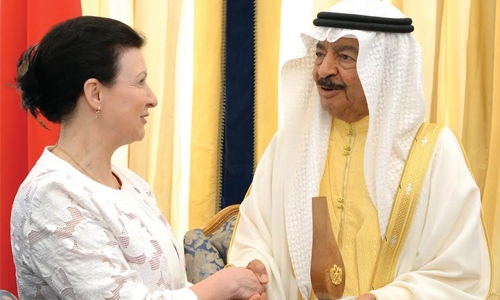A glimpse into the history of the Habsburg family
Manama : Prime Minister HRH Prince Khalifa bin Salman Al Khalifa has become the first Arab Prime Minister to receive the ‘Flame of Peace’ Award granted by the Association for the Furtherance of Peace. Prince Khalifa was presented the award by the association president Archduchess Herta Margarete at a ceremony held in the capital Manama, in the presence of Vice-President Archduke Sandor von Habsburg, ministers and senior Bahraini officials.
This award to the Prime Minister has urged researchers to look into history of the Habsburg family, which enjoys a long history as one of the oldest dynasties in Europe.
The Association has played a prominent role in support of the humanitarian action, international peace and closer relations between the peoples of the world.
The House of Habsburg, or House of Austria, was one of the most influential Royal houses of Europe. The throne of the Holy Roman Empire was continuously occupied by the Habsburgs between 1438 and 1740.
The house also produced emperors and kings of the Kingdoms of Bohemia, England (Jure uxoris King), France (Queen consort), Germany, Hungary, Croatia, Empire of Russia, Second Mexican Empire, Ireland (Jure uxoris King), Portugal, and Habsburg Spain, besides rulers of several Dutch and Italian principalities.
From the sixteenth century, following the reign of Charles V, the dynasty was split between Austrian and Spanish branches. Although they ruled distinct territories, they nevertheless maintained close relations and frequently
intermarried.
The House takes its name from Habsburg Castle, a fortress built in the 1020s in present-day Switzerland by Count Radbot of Klettgau, who chose to name his fortress Habsburg. His grandson Otto II was the first to take the fortress name as his own, adding “Count of Habsburg” to his title.
The House of Habsburg gathered dynastic momentum through the 11th, 12th, and 13th centuries. By 1276, Count Radbot’s seventh generation descendant Rudolph of Habsburg had moved the family’s power base from Habsburg Castle to the Duchy of Austria. Rudolph had become King of Germany in 1273, and the dynasty of the House of Habsburg was truly entrenched in 1276 when Rudolph became ruler of Austria, which the Habsburgs ruled until 1918.
A series of dynastic marriages enabled the family to vastly expand its domains to include Burgundy, Spain and its colonial empire, Bohemia, Hungary, and other territories. In the 16th century, the family separated into the senior Habsburg Spain and the junior Habsburg Monarchy branches, who settled their mutual claims in the Oñate treaty.
The House of Habsburg became extinct in the 18th century. The senior Spanish branch ended upon the death of Charles II of Spain in 1700 and was replaced by the House of Bourbon. The remaining Austrian branch went extinct in the male line in 1740 with the death of Holy Roman Emperor Charles VI, and completely in 1780 with the death of his eldest daughter Maria Theresa of Austria.
It was succeeded by the Vaudemont branch of the House of Lorraine. The new successor house styled itself formally as House of Habsburg-Lorraine (German: Habsburg-Lothringen), although it was often referred to as simply the House of Habsburg.
Related Posts

